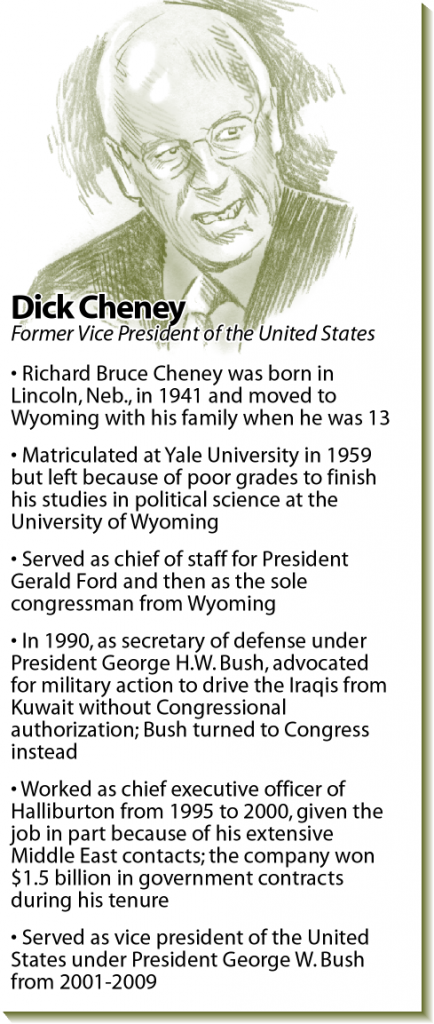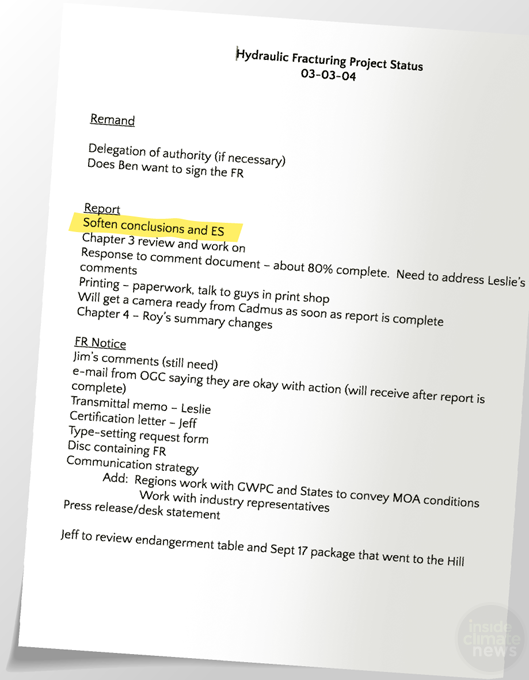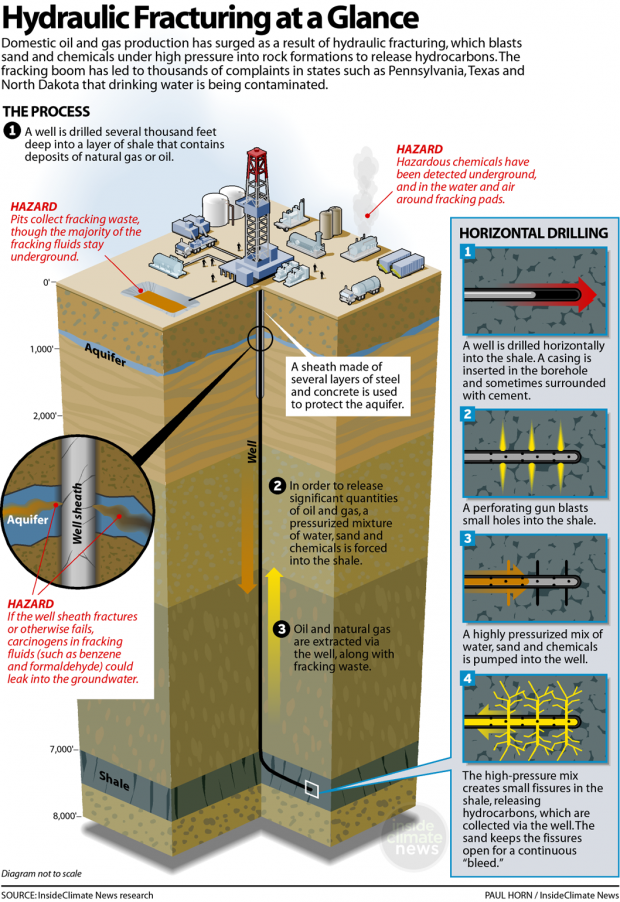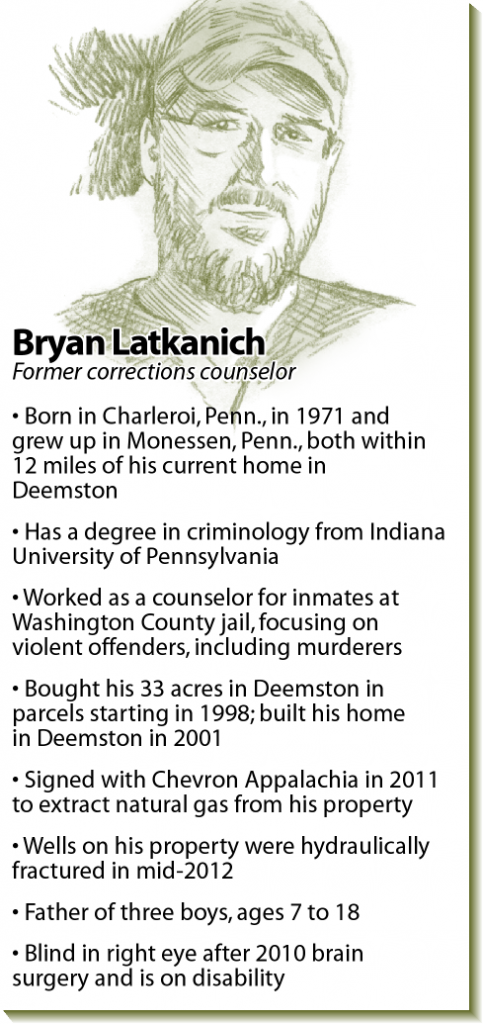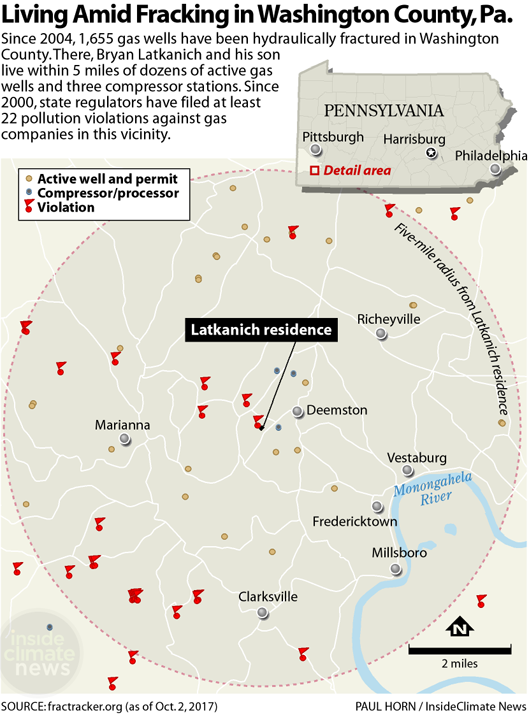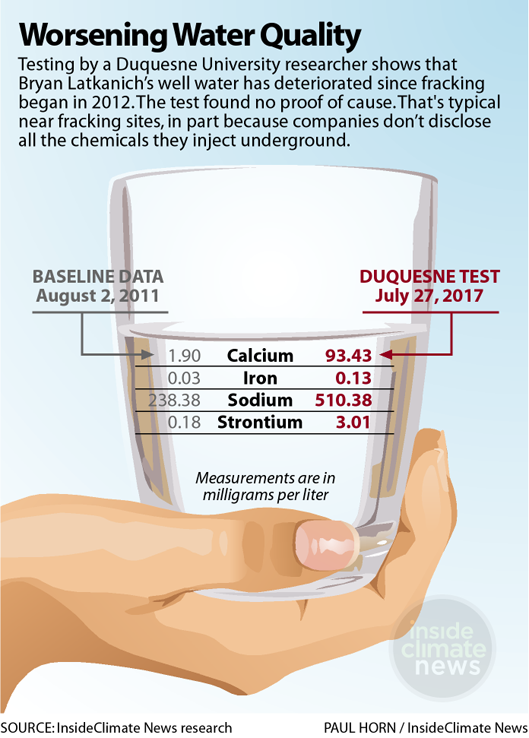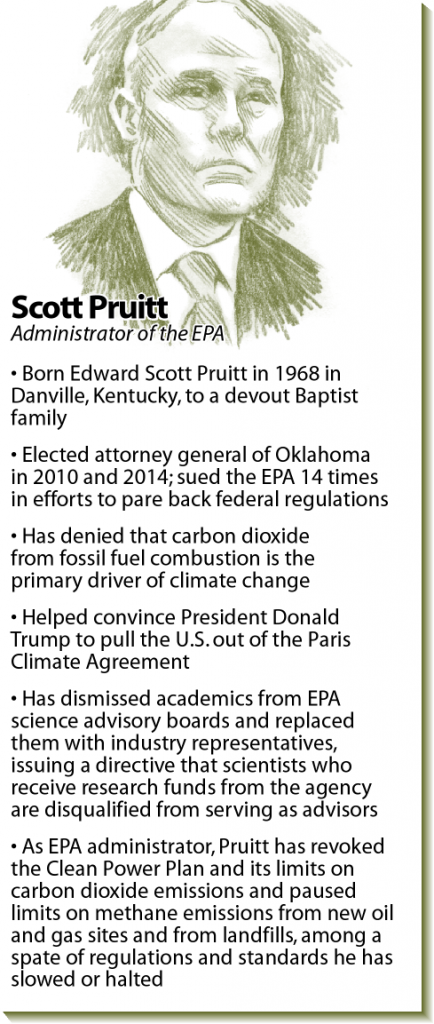Special report: How the U.S. government hid fracking’s risks to drinking water
-
Neela Banerjee/Inside Climate News
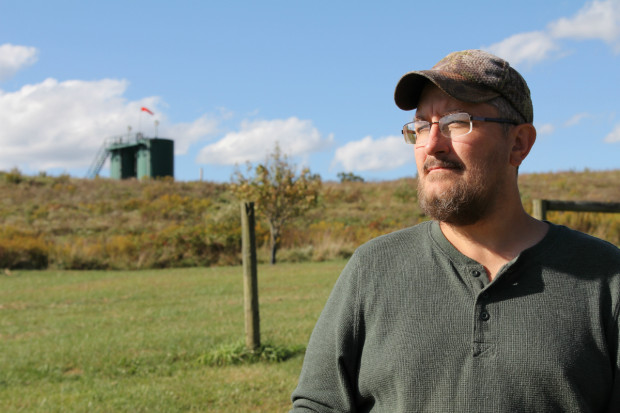
Anna Belle Peevey
The two wells drilled on Bryan Latkanich’s property are among 1,655 that have been hydraulically fractured in Washington County since 2004. Latkanich is one of more than 4,000 Pennsylvania residents who have filed complaints with DEP, wondering if gas drilling impacted their water. Only 284 cases have been linked.
Most mornings, when his 7-year-old son Ryan gets up for school at 6:55, Bryan Latkanich is still awake from the night before, looking online for another home in some part of Pennsylvania with good schools and good water.
Six years ago, Latkanich signed on to let an energy company tap natural gas beneath his property by pumping water, sand and chemicals into rock formations, a process called hydraulic fracturing, or fracking. Soon after, Latkanich’s well water got a metallic taste, he developed stomach problems, and his son one day emerged from a bath covered in bleeding sores. More recently, Ryan became incontinent.
Listen: Life under the Halliburton loophole, Susan Phillips, StateImpact Pennsylvania
Testing by state regulators and a researcher at nearby Duquesne University showed the well water had deteriorated since gas extraction started but no proof of the cause. The state recently began another round of testing.
Watch: Living With Fracking in Washington County, Pennsylvania
Latkanich is a single parent. He’s jobless and blind in his right eye from brain surgery. “I worry about my son getting sick, about my getting sick and what would happen to him if I did,” he said. “I’m doing this all alone. And I keep asking myself, ‘How do we get out?'”
For Latkanich and all those who believe their water has been tainted by fracking, there are few remedies. Congress took away the most powerful one in 2005, prohibiting the Environmental Protection Agency from safeguarding drinking water that might be harmed by fracking and even denying the regulator the authority to find out what chemicals companies use. That provision of the Energy Policy Act was justified by an EPA study about fracking into coalbed methane reservoirs, completed under the George W. Bush administration, that concluded that fracking posed no risk to drinking water.
Concerns about the study emerged from the outset, including a 2004 whistleblower complaint that called it “scientifically unsound.” Now, InsideClimate News has learned that the scientists who wrote the report disagreed with the conclusion imposed by the Bush EPA, saying there was not enough evidence to support it. The authors, who worked for a government contractor, went so far as to have their company’s name and their own removed from the final document.
At EPA, “there was a preconceived conclusion that there’s no risk associated with hydraulic fracturing into coalbed methane. That finding made its way into the Energy Policy Act, but with broader implications,” said Chi Ho Sham, the group manager of a team of scientists and engineers for The Cadmus Group, the Massachusetts firm hired to do the report. “What we would have said in the conclusion is that there is some form of risk from hydraulic fracturing to groundwater. How you quantify it would require further analyses, but, in general, there is some risk.”
The fracking provision, widely known as the Halliburton loophole, after the oilfield services company once run by Bush’s vice president, Dick Cheney, is among a host of exemptions to federal pollution rules that Congress and successive administrations have given oil and gas companies over the last 40 years.
Winning these exemptions is at the heart of a successful strategy by the fossil fuel industry and its allies in Washington to limit environmental oversight of companies’ operations. As a result, oil and gas drilling and production are exempt from laws regulating hazardous waste, chemical-laced runoff from well sites and toxic air pollution from well equipment. Some exemptions, such as the Halliburton loophole, were justified by EPA studies whose findings were ignored or bent to political ends, according to documents and interviews with scientists, lawmakers and former regulators who have worked on federal rulemaking since the late 1970s.
The Cadmus study was not the first EPA report to have its science thwarted, and under President Donald Trump, it likely won’t be the last. Current EPA Administrator Scott Pruitt is a staunch ally of fossil fuels, and his agency is moving on several fronts to quash science that documents the oil industry’s contributions to climate change and other forms of pollution, the first step to rolling back regulations, critics said.
“I’ve been caught off-guard by how fast and diverse the attacks are on scientists within the government and how science is used,” said Gretchen Goldman, research director for the Center for Science and Democracy at the Union of Concerned Scientists.
The EPA did not respond to multiple requests for comment made over two months. Former EPA officials from the Bush administration involved with the study would not comment on the record. Cadmus also would not comment and referred inquiries to the EPA.
The consequences of loopholes built on disputed science have rippled through the country during the latest energy boom. Domestic production of oil and gas has surged, creating thousands of jobs and boosting company profits—and leading to thousands of complaints in states such as Pennsylvania, Texas and North Dakota that drinking water is being contaminated. But, in the absence of federal protections, there is only a patchwork of often-lax state regulations. If it were not for the Halliburton loophole, the EPA could have developed standards for the entire country. State rules could have been tougher, but not weaker, than the national standards, and if states failed to regulate effectively, citizens could have petitioned the federal government to intervene.
“My dream was to build houses on this land for my sons and their families when they grew up, and to start a truck farm when I retired,” Latkanich said. “Now I’m just fighting a battle by myself against a billion dollar company.”
Chevron Comes Calling: ‘This Was a Godsend’
Before four Chevron Appalachia employees came calling in 2011 with promises of riches, Latkanich’s life had crumbled. In 1998, he had used an inheritance to buy land from a farmer in Deemston, 35 miles south of Pittsburgh. Latkanich was a counselor at the Washington County jail, often working with murderers. His wife was a nurse at a state penitentiary. They bought the rural tract as a haven from their tough jobs and built a dream house on a hill, with a wide front porch overlooking a two-acre pond.
But by 2010, the marriage had ended. His wife had left for a nearby town with his two older sons. Latkanich underwent an operation to remove a benign brain tumor, which, because of its size and location, threatened his life. While he was in a coma, his girlfriend gave birth to Ryan. She was addicted to cocaine and opioids, and the newborn spent three weeks going through withdrawal. The state placed Ryan in foster care.
When Chevron Appalachia showed up, Latkanich was on disability. He had spent the year in a hospital bed in his dining room with failing kidneys, back problems and $150,000 in bills from lawyers handling his divorce and efforts to regain custody of Ryan. Chevron offered him $400 for each of his 33 acres and estimated thousands more in royalties a month once the gas started to flow. He signed on. “In my situation, when it looked like I could lose everything, this was a godsend,” he said.
To Regulate or Not: Industry Gets Boost From Cheney
The two wells on Latkanich’s property are among 1,655 that have been hydraulically fractured in Washington County since 2004. Halliburton fracked the first commercial well in the United States in 1949. Technology has improved over time, getting a big boost from more than $135 million in federal grants beginning in the 1970s to spur development of oil and gas in shale formations. In the 1990s, fracking was used to extract coalbed methane, or natural gas, touted then as the next great investment for the industry.
The EPA and industry long maintained that fracking did not need federal oversight under the Safe Drinking Water Act (SDWA). The EPA used the law to protect groundwater from other industrial activities, such as disposal of oilfield wastewater as part its Underground Injection Control (UIC) program. But the agency contended that fracking did not fall under the UIC program and state oversight was adequate.
That assertion was successfully challenged in 1997 when the Legal Environmental Assistance Foundation (LEAF) won a case against the EPA on behalf of an Alabama couple who said their well water had been contaminated by nearby fracking for coalbed methane. The LEAF suit alleged that federal oversight of fracking under the SDWA was needed because the process was in fact a form of underground injection and state regulation was insufficient.
LEAF’s success scared the industry and politicians allied with it, said Hannah Wiseman, a law professor at Florida State University. They didn’t want federal rules that would have required a UIC permit for each frack job, potentially slowing energy extraction and choking revenues.
In 1999, Sens. James Inhofe (R-Okla.) and Jeff Sessions (R-Ala.), longtime allies of the oil industry, introduced a bill to exempt fracking from the Safe Drinking Water Act. A year later, the EPA announced a study to determine if fracking into coalbed methane reservoirs affected drinking water.
Industry got a huge boost when Cheney, the CEO of Halliburton, became vice president in 2001. At the time, fracking was unknown to the broader public. But an energy policy task force Cheney helmed in spring 2001 highlighted fracking’s potential, and it recommended a comprehensive exemption to the SDWA for all types of fracking, not just for coalbed methane. The EPA cautioned against an overly broad approach.
EPA Administrator Christine Todd Whitman wrote to Cheney on May 4, 2001, “I strongly suggest limiting the recommendation to the problem we know about—hydraulic fracturing for coalbed methane. Otherwise, before the (coalbed methane) study is completed, we are potentially walking into a trap because we don’t yet know the environmental consequences of the broader exemption, or why it is needed.”
A draft version of the coalbed methane report was released in 2002 for public comment. Industry and environmental activists alike remarked on the disparity between the details of the study, which noted the possibility of threats to drinking water from fracking with toxic chemicals, and the overall conclusion, which stated that fracking was entirely safe. Industry wanted the details changed; activists wanted the conclusion amended to reflect the details.
EPA’s Own Contractor Finds Fracking Poses Risks; EPA Dismisses It
Cadmus took over the report in late 2002 from the original contractor. The project faced obstacles from the outset, according to EPA documents and Cadmus staff. The oil and gas industry declined to provide information about the composition of fracking fluids, asserting that they were trade secrets. There wasn’t enough time or money for Cadmus to begin monitoring groundwater before, during and after fracking jobs to see if the process affected water quality. With little insight into what was actually pumped into the earth during fracking, Cadmus researchers had to rely on existing literature and discussions with a limited number of experts familiar with the process.
Cadmus sent chapters of its working draft to the EPA starting in mid-2003. The agency immediately questioned the validity of the findings. Against common scientific practice, the EPA urged Cadmus to include an oil industry study that had not been peer-reviewed. When Cadmus staff resisted, the EPA manager asked a Cadmus scientist, “‘Can’t you say something positive about it?'” the scientist recalled.
The industry study fell by the wayside. But the EPA changed parts of the working draft that suggested fracking for coalbed methane could pose risks to drinking water, according to the documents and Cadmus scientists.
A March 3, 2004, EPA agenda entitled “Hydraulic Fracturing Project Status” listed among the tasks “Soften conclusions and ES [executive summary].”
In drafts of the executive summary, typically a report’s most widely read section, the authors referred to potential threats to public health as the reason for the study. “The goal of this Phase I study was to determine if a threat to public health exists as a result of USDW [Underground Sources of Drinking Water] contamination from hydraulic fracturing fluid injection into CBM [coalbed methane] wells, and if it does, whether the threat is great enough to warrant further study,” the authors wrote.
The final version of the report omits mention of public health except in the discussion of methodology and in paraphrasing public comments deep into the 463-page study.
EPA documents show Cadmus recommended revisions to reflect complaints by some Virginia residents about possible contamination of their water from fracking. The contractor raised the question of an investigation to see if the complaints were warranted. The final version did not include the changes Cadmus recommended, and EPA did not launch an inquiry into the complaints.
The Cadmus scientists said they realized over time that their findings about risks to underground drinking water diverged from what the EPA wanted. The scientists determined that fracking does pose some risk to drinking water. They concluded that monitoring of fracking activities and more information from industry would be needed to quantify the risk. The EPA decided the study’s conclusion should be that fracking did not pose a threat to groundwater and therefore did not require further study or federal oversight.
The Cadmus scientists came to believe that abiding by the EPA’s conclusion violated their standards of integrity. “If you say there is no risk associated with hydraulic fracturing, and we see risk, you either didn’t do a good job or you’re lying,” Sham said. “The data and analyses tell us there is risk associated with it, and we were asked to report there is no risk, and we can’t say that.”
The EPA routinely hires contractors to conduct studies, and the firms’ names are generally tucked away in appendices or acknowledgements. Contractors appreciate a mention because if the studies are well-regarded, they serve as a form of marketing. The 2004 coalbed methane study notes the use of a contractor but does not identify Cadmus.
“We had no power over the final report. The only power we had was to take our names off it,” said a Cadmus team scientist who declined to be identified because of concerns about job security.
Inside the EPA, some scientists were also troubled by the study. “What I found objectionable was that it was written to have a good P.R. effect on people,” said Mario Salazar, an engineer who was an internal reviewer of the report and worked as a technical expert at the EPA’s underground injection office. “So that people would read the report and say there was no problem with hydraulic fracturing and water.”
After the EPA published the final coalbed methane report in June 2004, Weston Wilson, an environmental engineer in the EPA’s Denver office, filed a formal whistleblower complaint about it. Wilson alleged in his complaint that the study’s conclusions were “unsupportable” and based on “limited research.”
The EPA’s inspector general launched an investigation into Wilson’s complaint. But the inquiry was closed after the Republican-controlled Congress passed the Energy Policy Act in 2005, codifying in law the conclusion of the coalbed methane study and exempting fracking from the Safe Drinking Water Act.
Back in Pennsylvania, A Boy’s Health Problems Grow
In mid-2012, Chevron Appalachia hydraulically fractured two wells on a hill about 400 feet behind Latkanich’s house. They produced gas by winter, and Latkanich got royalty checks that at first were as high as $11,000 a month. He paid off legal bills and his mortgage.
The company carved out a two-acre well pad from the hillside for three large impoundments to hold water from other gas sites that was trucked in to frack the two Latkanich wells. During a hard rain or snowmelt, runoff from the well pad flowed down the hill, over the site of Latkanich’s well, and into his garage and basement.
Latkanich’s drinking water developed a metallic taste over the course of the year. He started to get frequent diarrhea. In early 2013, Ryan, then 3, came out of the tub covered in open sores. Latkanich called the state Department of Environmental Protection (DEP) to test the water. Chevron Appalachia declined to hook up Latkanich’s home to the nearby municipal water system and provided him with a large outdoor tank instead. The DEP tests did not show anything wrong with the drinking water, and the company took the tank away.
Still worried even after the 2013 tests, Latkanich began to have bottled water delivered. Because he’s on a fixed income, Latkanich and Ryan use it only for drinking. They still cook, brush their teeth, bathe and wash dishes and clothes in well water. Ryan’s mother left in August 2013.
In December 2016, Ryan started to soil himself almost daily. He was 6, a chubby precocious redhead with perpetually askew glasses. One day, he soiled himself at school. “Charlie was the smartest kid in the class. He was making fun of me in front of the whole class. He said I stink,” Ryan recalled. He doesn’t have many friends at school now. “I’ll never forget that.”
Medical tests found nothing wrong with Ryan. Peer-reviewed science has been mixed so far about the links between fracking and incontinence or gastrointestinal problems among residents who use nearby well water. Latkanich called the state DEP to test his water. He also contacted John Stolz, director of Duquesne University’s Center for Environmental Research and Education.
The results have been ambiguous. Unlike most people, Latkanich had an independent lab test his water in 2011 before fracking began, giving him a baseline. In its February 2017 test, the state found increased turbidity, or cloudiness, and the presence of coliform bacteria. DEP officials returned in early November to take more samples. Stolz’s test found higher levels of iron, calcium and strontium. The amount of sodium had more than doubled to 510.38 milligrams per liter of water from 238.38 in 2011, before fracking began.
The elevated levels of sodium pose a high risk to Latkanich, who suffers from kidney disease. “The test results prove I can’t drink this water,” he said.
The ambiguity is typical of water tested near fracking sites. If water quality has worsened, there is seldom a bright line to the fracking. That’s partly because under the Halliburton loophole, companies do not reveal everything they inject underground, so labs do not know all the substances they should test for. And in many cases, homeowners enter into settlements with energy companies that prohibit them from revealing what happened.
Chevron Appalachia has not seen Latkanich’s 2017 water test results, but a spokeswoman said that past water testing didn’t support his claim that fracking affected his water. “Based on a review of the 2011 pre-drill and 2013 post-drill water samples, both Chevron and the DEP concluded that Chevron Appalachia’s operations did not affect Mr. Latkanich’s water,” Veronica Flores-Paniagua said in an email. ”We understand that Mr. Latkanich has recently raised the same concerns again regarding his well water. As always, Chevron Appalachia will continue to fully cooperate with the DEP in this matter.”
The Legacy of the Now-Disputed EPA Study
When the Energy Policy Act passed, the industry celebrated the exemption of fracking from safe drinking water scrutiny and cited the now-disputed EPA study whenever complaints about pollution arose. In a September 2005 newsletter, the Interstate Oil and Gas Compact Commission said the study had found “no confirmed cases that drinking water wells had been contaminated by hydraulic fracturing fluid injection into coal bed methane wells.”
“It was the one big study. You heard it quoted for a decade or more after: that fracking never harmed water,” said Greg Dotson, a law professor at the University of Oregon and former lead energy policy staffer for Rep. Henry Waxman of California, the top Democrat on the House Energy and Commerce committee during the Bush era. For members of Congress, “if you wanted to do the right thing, you needed to have data on your side, and this study deprived you of an analytical basis. … The oil and gas guys always used it. It was instrumental to their winning the debate.”
The Trump EPA does not try to hide its intention to roll back rules to help oil and gas. Before taking the reins at EPA, Pruitt built a career based on deep ties to industry. He led a political non-profit funded in part by the petrochemical billionaires Charles and David Koch. He sued the EPA more than a dozen times as Oklahoma attorney general over new pollution standards. As EPA administrator, he has halted or slowed several rules affecting oil and gas.
He has moved to undermine the scientific underpinnings of major rules in part by removing independent academics from the agency’s scientific advisory panels that review studies on issues such as fracking. In their place, the Pruitt team has put forth the names of corporate representatives, many drawn from the oil and gas industry, who deny prevailing science on public health hazards such as climate change and ozone.
EPA Issues New Report, but Change Is Unlikely
In December 2016, as the Obama administration was about to leave office, the EPA issued a new report, which stated for the first time that fracking in some cases had contaminated drinking water. It identified possible risks to groundwater unless certain safeguards are implemented. Cadmus was the government contractor who helped conduct the study, and this time, its name is repeatedly mentioned in it.
The new study won’t change anything on the ground unless Congress acts to repeal the Halliburton loophole, which is unlikely for the present.
Latkanich expects no help from the government. It allowed all he sees around him to happen, he figures. He has a reputation with Chevron as a troublemaker because he monitors and criticizes its practices. Early on, he grew suspicious of the company when he learned from a neighbor that a Chevron contractor had allowed stormwater to runoff into a stream on the other side of his property. The company was cited by the state, but Chevron and state regulators did not tell Latkanich about the violation, he said.
Latkanich would like to stay in his house, which he poured thousands of dollars into because he thought he would grow old in it. Now, his fears about the well water nudge him to go, but he worries he can’t find a buyer. “I can’t sell the house now: It has foundation issues and pollution. The value of the house has dropped like a rock,” he said.
The most likely buyer would be Chevron, and Latkanich is determined to wrest accountability for the damage he believes the company has done. But he can’t afford a lawyer to help him negotiate a settlement. One non-profit told him his case was too big and complex for it to handle. He gets a disability check and about $550 monthly now in royalties for his two gas wells, so he doesn’t have the money to hire private firms.
“This farm is ruined,” he said.
“Forever,” said Ryan, who had come into the kitchen from running around outside.
“Buy me out and I’ll move somewhere where there isn’t fracking,” Latkanich said.
“Japan?” Ryan offered. “Because I don’t think there’s fracking there.”


